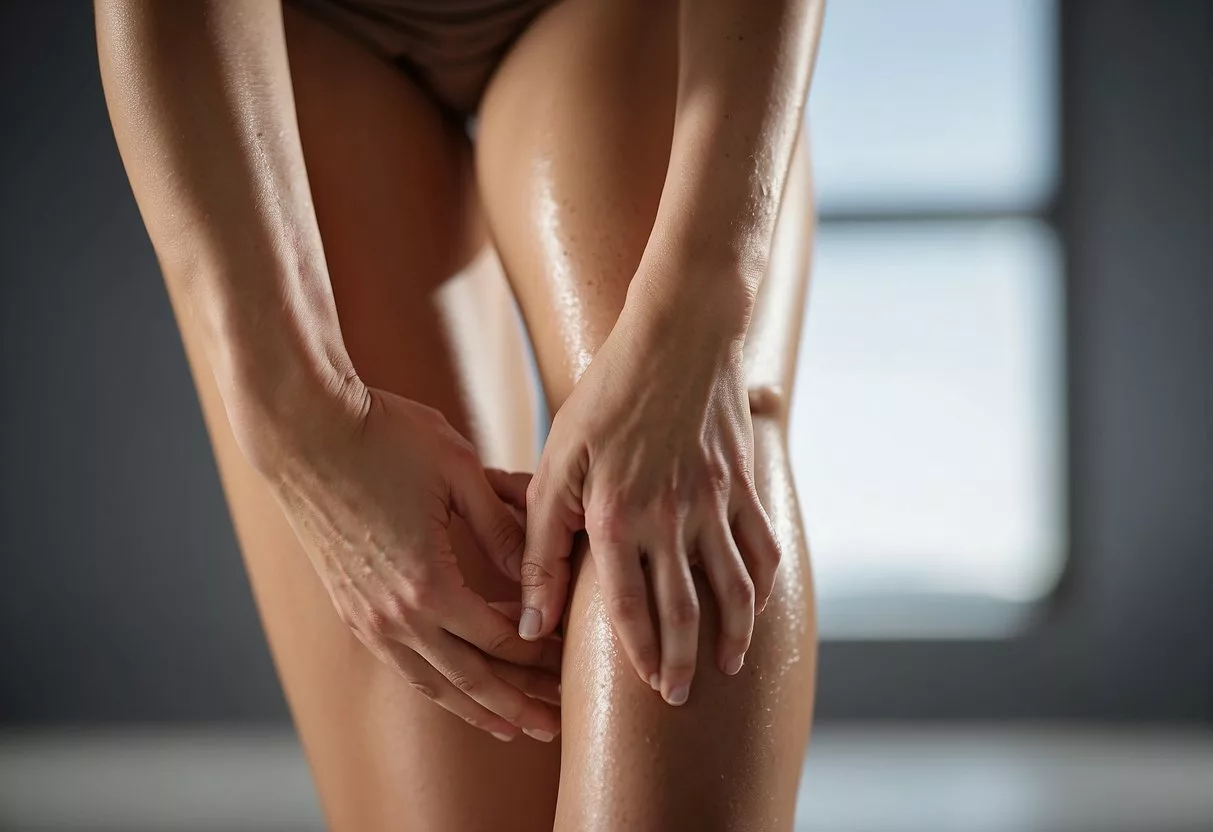Achieving significant weight loss is a commendable goal and brings many health benefits, but it can come with the unexpected challenge of loose skin. This is a common issue for individuals who have lost a considerable amount of weight, particularly when weight loss has been rapid.
Your skin may struggle to shrink back to its former size and shape due to lost elasticity and the reduced volume of fat that once stretched the skin.

Fortunately, there are ways to tighten this loose skin and improve its appearance.
Lifestyle changes, such as maintaining a healthy diet and engaging in regular exercise, can enhance skin elasticity and build muscle mass, providing natural support for your skin.
Various non-surgical treatments like massage, radiofrequency therapy, and compression garments offer additional avenues to manage skin laxity.
For those seeking more dramatic results, cosmetic procedures can provide more definitive solutions, although these should be carefully considered for potential risks and recovery time involved.
Key Takeaways
- Significant weight loss can lead to loose skin, which may require intervention to tighten.
- A combination of lifestyle changes and non-surgical treatments can improve skin elasticity.
- Cosmetic procedures offer more substantial results but come with potential risks and recovery considerations.
Effects of Weight Loss on Skin Elasticity

Skin elasticity refers to the skin’s ability to stretch and return to its original state. Effective weight loss strategies often overlook the skin’s capacity to conform to the body’s new shape, a process highly influenced by proteins like collagen and elastin, as well as various biological factors.
Role of Collagen and Elastin
Collagen and elastin are proteins crucial for skin elasticity. Collagen provides rigidity and strength, while elastin allows the skin to be flexible.
When an individual loses weight, the skin may struggle to retract due to the reduced presence of these proteins.
Nutrition plays a vital role in supporting these proteins; consuming nutrients like vitamin C, zinc, vitamin E, omega-3 fatty acids, and selenium can help maintain healthy skin.
Additionally, taking a collagen supplement may support the skin’s elasticity.
Impact of Age and Genetics on Skin Elasticity
Skin elasticity decreases with age as collagen and elastin production naturally decline.
Genetics also determine skin’s resilience. An individual’s genetic makeup influences how their skin reacts to weight change.
Those with a genetic predisposition for stronger elastin fibers may experience less loose skin after weight loss. Conversely, a genetic tendency for weaker collagen bonds can result in more pronounced skin laxity with age or after significant weight changes.
Lifestyle Factors Affecting Skin Tightness

The tightness of one’s skin post-weight loss can be significantly influenced by certain lifestyle choices. These include dietary habits, hydration levels, tobacco and alcohol use, and the approach to skin care and sun protection.
Each factor plays a crucial role and requires specific attention for optimal skin health.
Effects of Diet and Nutrition
Good nutrition is pivotal in maintaining skin elasticity. Diets rich in fruits, vegetables, and lean proteins can provide the necessary vitamins and minerals that support skin repair and collagen production.
Essential fatty acids, found in foods like fish and nuts, are vital for skin health.
Importance of Hydration for Skin Health
Hydration greatly influences skin elasticity.
Experts recommend drinking plenty of water to maintain hydration levels.
Proper water intake ensures that the skin remains supple and can bounce back more easily after significant weight loss.
Consequences of Smoking and Alcohol Consumption
Smoking significantly impairs skin health by reducing collagen production, which is necessary for skin elasticity.
Similarly, excessive alcohol consumption dehydrates the body and skin, potentially exacerbating issues with loose skin.
Sun Protection and Skin Care
The skin’s exposure to the sun can degrade collagen and elastin over time.
Applying sun protection with a high SPF is critical in preventing this damage.
Using a moisturizer can help keep the skin hydrated and promote elasticity.
Non-Surgical Methods for Improving Skin Tightness

After weight loss, many individuals seek ways to tighten their skin without surgical intervention. This section discusses various non-surgical methods that can aid in improving skin tightness, including specific exercises, muscle building, and topical treatments rich in beneficial compounds.
Effective Exercises for Skin Tightening
Exercise plays a pivotal role in tightening loose skin following weight loss.
Incorporating a mix of cardio and strength training into one’s fitness routine can enhance skin elasticity.
For example, activities like swimming or yoga improve overall physical activity and help tighten the skin.
Resistance training is particularly effective as it builds underlying muscle, which can reduce the appearance of saggy skin.
Importance of Building Muscle Mass
Building muscle mass is essential for improving the look of loose skin.
Strength training exercises, such as weightlifting, promote muscle growth underneath the skin, making it appear tighter and more toned.
Regularly engaging in fitness routines that focus on major muscle groups can significantly enhance skin firmness and reduce sagging.
Utilizing Firming Creams and Moisturizers
Topical applications of firming creams and moisturizers can complement physical efforts to tighten skin.
These products often contain ingredients like retinol, peptides, and hyaluronic acid that are known for their skin-firming properties.
Regular application can lead to a noticeably firmer skin appearance over time.
For optimal results, look for creams with a high protein content or those specifically formulated for post-weight loss skin tightening.
Benefits of Vitamins and Supplements
Supplementing one’s diet with vitamins and specialized collagen supplements may support skin tightening efforts.
Vitamin C is crucial for collagen synthesis, promoting skin elasticity and firmness.
A balanced diet rich in nutrients, along with targeted supplements, can provide the skin with the necessary building blocks to improve its condition and elasticity after weight loss.
Medical and Cosmetic Treatments

For individuals seeking firmer skin following significant weight loss, various medical and cosmetic treatments are available. These can range from non-invasive procedures to full surgical interventions, each with its specific approach towards enhancing skin elasticity and appearance.
Radiofrequency Treatments for Skin Elasticity
Radiofrequency treatments involve the use of energy waves to heat the dermis and promote collagen production, which can lead to tighter skin.
Treatments such as radiofrequency therapy may also combine infrared light and massage to enhance results.
Understanding Body-Contouring Surgery Options
After major weight loss, especially following bariatric surgery, excess skin can be a concern.
Body-contouring surgeries, such as abdominoplasty (tummy tuck), brachioplasty (arm lift), and thigh lift, can remove this excess skin and improve contours.
Minimally Invasive Techniques
For those hesitant about extensive surgery, minimally invasive options offer an alternative.
Techniques such as thread lifts use substances like Polydioxanone (PDO) to tighten skin by lifting and supporting subdermal tissues, applicable to various body parts including the face, chest, and buttocks.
The Role of a Plastic Surgeon in Tightening Loose Skin
A consultation with a certified plastic surgeon is paramount in determining the appropriate treatment for skin tightening.
Surgeons can guide patients through the options, from ultrasound treatments to more comprehensive plastic surgery, ensuring safe and effective results tailored to the patient’s needs.
Potential Risks and Recovery After Tightening Procedures

When considering skin-tightening procedures after weight loss, it’s essential to be aware of the potential risks involved and understand the recovery process. This section explores the risks of surgeries, outlines recovery timelines, and discusses managing discomfort and scarring.
Addressing the Risks of Skin-Tightening Surgeries
Skin-tightening surgeries, while effective, come with inherent risks that should not be overlooked.
Infection is a concern, as with any invasive procedure, and it’s crucial for patients to follow post-operative instructions to minimize this risk.
Other potential side effects may include bruising, swelling, and sensitivity in the treated areas. There is also a small chance of more serious complications such as blood clots or adverse reactions to anesthesia.
Recovery Process and Timelines
Recovery from skin-tightening procedures varies depending on the type of surgery performed.
Generally, patients can expect the initial healing phase to last several weeks, during which activities may be limited.
For instance, recovery from a facelift often requires two to three weeks before returning to normal activities, while non-surgical procedures might have significantly shorter recovery times.
| Procedure Type | Estimated Recovery Time |
|---|---|
| Facelift | 2-3 weeks |
| Minor lifts | 1-2 weeks |
| Non-surgical lifts | Few days to 1 week |
Coping with Discomfort and Scarring
Post-procedure discomfort is usually managed with prescribed pain medication and ice packs to reduce swelling. Patients should be prepared for some level of discomfort in the days following the procedure as the body begins to heal.
As for scarring, surgeons typically place incisions in less visible areas to minimize their appearance. However, some procedures may result in scars, which can fade over time with proper care.
To mitigate emotional distress associated with recovery, patients are advised to have a support system in place and consider counseling if necessary. Emotional well-being is a critical component of the recovery process.
Maintaining Results and Long-Term Skin Care

After achieving a tighter skin through various methods, it’s crucial to focus on sustainable practices that help maintain skin elasticity and overall wellness.
Adhering to a nutritious diet and healthy lifestyle can prolong these benefits.
Sustaining Skin Elasticity After Treatment
One’s skin recovery post-treatment largely depends on continuous care. Incorporating a regular fitness regimen is key to maintaining muscle mass, which supports the skin’s structure.
Adequate protein intake is also essential, as it provides the building blocks for skin repair. Engaging with a dermatologist can further guide the choice of topical treatments that help sustain the skin’s elasticity.
Continued Importance of Nutrition and Lifestyle
Nutrition plays a vital role in skin health. A balanced diet rich in vitamins, minerals, and antioxidants is critical for repairing skin and supporting its firmness.
Specifically, foods high in vitamin C and zinc support collagen production, which is integral to skin elasticity. Coupled with hydration and regular exercise, one’s nutrition can significantly impact the longevity of skin tightening results.
Addressing Body Image and Emotional Well-Being
It is not uncommon for individuals who have lost significant weight to experience concerns about body image and possible emotional distress related to excess skin.
It is important to appreciate one’s achievements and address any negative feelings by seeking support from communities or professionals who understand the emotional aspects of weight loss. Continual self-care and positive reinforcement are vital for long-term emotional health and body confidence.
Frequently Asked Questions

This section addresses common queries regarding skin tightening post-weight loss, including non-surgical methods, supplements, and special considerations for individuals over 50.
What non-surgical options are available to tighten skin after weight loss?
There are multiple non-surgical options for skin tightening. These include topical treatments such as gels and creams formulated with ingredients like hyaluronic acid and retinol, as well as lifestyle changes involving hydration and nutrition. Using compression garments may also be beneficial.
Which supplements are beneficial for improving skin elasticity post-weight loss?
Supplements containing collagen and vitamins A, C, and E are often touted as beneficial for skin elasticity. Adequate protein intake, including the amino acids lysine and proline, is also crucial for skin health.
How can individuals over 50 address loose skin following weight reduction?
As the skin loses elasticity with age, individuals over 50 may need to incorporate both topical treatments and targeted exercises. Ensuring proper hydration and considering supplements that support skin structure, such as collagen peptides, can be especially important for an older demographic.
Are there effective at-home methods for tightening skin after shedding pounds?
Yes, there are effective at-home methods for skin tightening, such as strength training to build muscle mass, which can help fill out loose skin. Regular exfoliation can also improve circulation and aid in tighter skin appearance.
What types of foods promote skin tightening after significant weight loss?
Foods rich in protein, omega-3 fatty acids, and antioxidants can help rebuild skin’s collagen. Including nuts, seeds, avocados, and lean meats in one’s diet can provide these nutrients.
What exercises are recommended to firm up saggy belly skin after losing weight?
Abdominal exercises like crunches, planks, and leg raises can strengthen the underlying muscles. They may improve the appearance of loose belly skin.
Incorporating full-body strength training can enhance overall muscle tone. This can potentially reduce sagging.